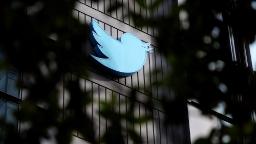[ad_1]

Washington
CNN Business
—
Two weeks after Elon Musk completed his acquisition of Twitter, the future of the company has never looked less certain.
In the past week alone, one of the world’s most influential social networks has laid off half its workforce; alienated powerful advertisers; blown up key aspects of its product, then repeatedly launched and un-launched other features aimed at compensating for it; and witnessed an exodus of senior executives.
The wild swings at Twitter only seemed to accelerate on Thursday with more executive departures, growing chaos over fake, verified accounts and an unusual public rebuke from the US government. Twitter now appears to be on the brink, a point Musk himself seemed to concede on Thursday by reportedly telling employees that bankruptcy could be on the horizon (though it’s far from the first time he’s warned about bankruptcy at one of his companies).
“Quite the day!” Musk tweeted.
It’s a stunning reversal of fortunes not just for Musk, who bought the company for $44 billion, but also for a platform used by some of the most powerful people on the planet, including world leaders, CEOs, and the Pope.
An end to the disruption seemed nowhere in sight on Friday. In its latest reversal on the matter, Twitter said it would re-introduce a gray “Official” badge for select accounts to help confirm their identities. The decision came after Twitter was forced to fend off a wave of verified-account impostors this week, including some posing as former President Donald Trump, Nintendo, and the pharmaceutical company Eli Lilly, among others. These accounts were the result of Musk’s decision to rush ahead with offering a blue check mark to any account holder willing to pay $8 a month, no questions asked, as he races to find new ways to make money from the platform.
That paid subscription service, too, was also suspended on Friday with little warning, just two days after its official launch, with the menu option to sign up for Twitter Blue suddenly disappearing from Twitter’s iOS app — the only place the add-on had been offered. It was not immediately clear when the company might restore the offering.
The gray “Official” badge has become an illustration of the whiplash users, employees, and advertisers have experienced in recent days.
Hours after the gray badges launched on Wednesday as a way to help users differentiate legitimate celebrity and branded accounts from accounts that had merely paid for a blue check mark, Musk abruptly tweeted that he had “killed” the feature, forcing subordinates to explain the reversal.
“We’re not currently putting an ‘Official’ label on accounts but we are aggressively going after impersonation and deception,” Twitter’s verified support account tweeted on Wednesday evening.
The account’s very next tweet, a day and nine hours later, said exactly the opposite: “To combat impersonation, we’ve added an ‘Official’ label to some accounts.”
Twitter did not immediately respond to a request for comment on the changes to the rollout of Twitter Blue or “Official” badges.
The paid verification feature’s rocky rollout attracted widespread criticism from misinformation experts who had warned it would make identifying trustworthy information much more difficult, particularly in the critical period following the US midterm elections. Even some of Musk’s fellow high-powered users of the platform had tough feedback.
“@elonmusk, from one entrepreneur to another, for when you have your customer service hat on. I just spent too much time muting all the newly purchased checkmark accts in an attempt to make my verified mentions useful again,” tweeted billionaire Mark Cuban.
“Bottom line is that you have a decision to make,” Cuban added. “Stick with the new Twitter that democratizes every tweet by paid accounts and puts the onus on all users to curate for themselves. Or bring back Twitter curation. One makes Twitter time and information efficient. The other is awful.”
In a Twitter Spaces event held for advertisers this week, Musk pleaded with brands to keep using the platform, after a growing number of companies paused ads, causing what Musk previously described as a “massive drop in revenue.” In the event, Musk sought to appear magnanimous in accepting responsibility for the company’s performance.
“If things go wrong, it’s my fault, because the buck stops with me,” he told an audience of over 100,000 listeners.
But privately, Musk’s critics have described the billionaire as dismissive of accountability, even in the face of scrutiny by the Federal Trade Commission, which publicly warned on Thursday, in a rare forward-looking statement, that it is “tracking recent developments at Twitter with deep concern.”
According to an internal Slack message posted by a Twitter employee and viewed by CNN, Musk has shown little fear of the FTC regulators overseeing the company’s multiple, legally binding consent agreements committing it to maintaining a robust cybersecurity program and producing written privacy impact reports before launching any new products or services, a requirement that could cover Twitter Blue.
The company is already facing billions in potential fines from the FTC over alleged privacy missteps dating to before Musk’s ownership. But, the Twitter employee warned colleagues, Twitter could find itself even more legally exposed after the sudden resignation of multiple top Twitter executives charged with fulfilling the company’s FTC obligations, including its chief information security officer and chief privacy officer.
Forced to address the looming risk of FTC oversight, Musk reportedly struck a conciliatory tone.
“Twitter will do whatever it takes to adhere to both the letter and spirit of the FTC consent decree,” Musk reportedly wrote in an email to employees Thursday evening.
The one thing Musk claims is going in his favor at Twitter is user growth, as more people tune in to watch him fumble his way through owning the company.
“Twitter usage is at an all-time high,” Musk tweeted earlier this week, before adding in a follow-up tweet: “I just hope the servers don’t melt!”
[ad_2]
Source link